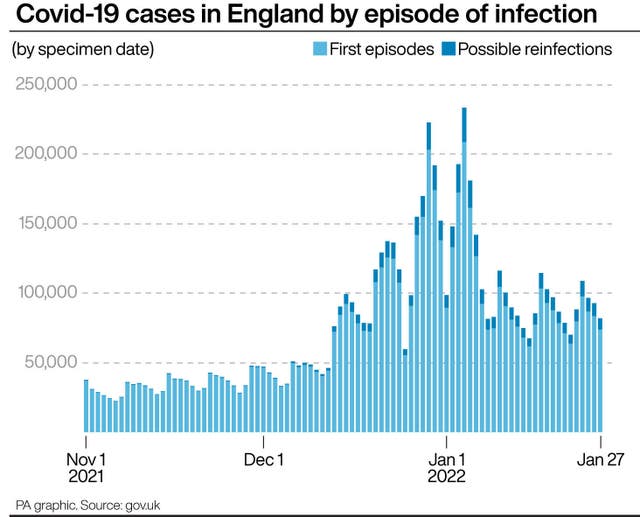London has the lowest pupil vaccine uptake for 12 to 15-year-olds
Pupils in deprived areas are much less likely to have been vaccinated, the latest figures show.

London has the lowest levels of uptake for pupils aged 12 to 15 getting their first dose of the vaccine in England, new figures have revealed.
In figures produced using the English Schools Census and National Immunisation Management System datasets for up to January 9, just over half – 52.5% – of pupils aged 12 to 15 in English state schools had received at least one dose of the Covid-19 vaccine, while 69.7% of pupils aged 16 to 17 had.
Just 5.8% of 12 to 15-year-olds had received two doses.
London had the lowest level of vaccine uptake amongst this age group, with just 40.1% of pupils vaccinated, compared with 60.7% – the highest level of uptake – in the South East.
After controlling for other demographic and socio-economic factors, pupils in the North West were least likely to be vaccinated, however.
The data showed that pupils from Chinese and Indian backgrounds were most likely to have received at least one dose of the Covid vaccine, with 75.5% of Chinese pupils and 65.7% of Indian pupils aged 12 to 15 having received at least a first dose.
Gypsy or Roma and Black Caribbean pupils were least likely to have been vaccinated, with 12.4% of both groups having been vaccinated.
“Although this is in part related to different levels of deprivation, large differences in the likelihood of being vaccinated by ethnic group still exist after accounting for available deprivation measures,” the ONS said.
Pupils eligible for free school meals (FSM) also had lower vaccine coverage than their peers, with just over a third – 35.9% – receiving one dose compared with 58.9% for non-FSM pupils.
Schools with higher proportions of pupils eligible for FSM were also found to have lower levels of vaccine coverage, and pupils living in deprived areas were also less likely to have been vaccinated.
In the most deprived areas of the country, the vaccination rate for 12 to 15-year-olds was 36.1%, while it was 70.3% in the least deprived areas.

Pupils with English as an additional language were less likely to get the jab than their peers, too, with 38.2% vaccinated in this group compared with 55.5% for native speakers.
And pupils with special educational needs were slightly less likely to have been vaccinated compared with their peers.
Last week, Government attendance data showed that 5.1% of all pupils were off school because of Covid on January 20, up from 3.9% on January 6 – a record high for this school year, with 415,300 pupils absent in total.
On Monday, Labour said that the Government needed to accelerate its Covid vaccination programme for children to stop “avoidable” absences from schools.
Shadow education minister Stephen Morgan said: “Vaccination is key to protecting our children in the classroom, but 46% of 12 to 15-year-olds still haven’t had their first dose.
“One in eight children were off school earlier this month, causing more avoidable disruption to their education.
Fiona Dawe, deputy director of wider surveillance studies at the Office for National Statistics (ONS), said: “Today’s data reveal more about those pupils aged 12-17 who have received at least one dose of a Covid-19 vaccine.
“As we can see, there are many different factors that contribute to vaccine uptake rates including, but not limited to, geography, deprivation and ethnicity.”
Dr Shamez Ladhani, consultant paediatrician at the UK Health Security Agency (UKHSA) and the study’s chief investigator, said: “The information collected through this questionnaire provides a real insight into attitudes towards vaccination – which has been proven to protect against hospitalisation and severe disease.
“With Covid-19 case rates currently high across school-age groups, it’s vital that we monitor and evaluate measures that help reduce transmission. We need families and students to continue to take part in the programme.”
Last week, vulnerable five to 11-year-olds become eligible for their first Covid-19 jab.
Julie McCulloch, director of policy at the Association of School and College Leaders (ASCL), said: “The initial rollout of Covid vaccinations to 12 to 17-year-olds in our schools and colleges appears to have been reasonably successful, according to these figures from the Office for National Statistics.
“But it is important to note that this is a snapshot of the vaccination effort as it stood at the end of the first full school week of January and before second jabs were offered to 12 to 15-year-olds,” she added.
“The significant regional variations in the number of students vaccinated are concerning and it is difficult to overlook that the areas with the lowest uptake – London and the North West – were hotspots for very high levels of student and staff absence at the end of the autumn term, a pattern that has largely continued during the first few weeks of the new year.
“Even more worrying is the low uptake of vaccinations among pupils eligible for free school meals and in the most disadvantaged areas of England, as well as among students who speak English as an additional language and those with special educational needs (SEN).
“These are the students who can least afford more time out of school. Vaccination is the key to controlling the spread of the coronavirus and the Government needs to step up its efforts to promote higher levels of take-up and prevent continuing disruption in our schools and colleges.”





